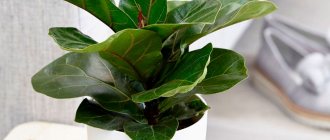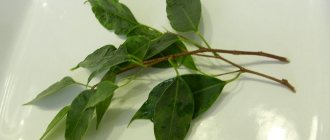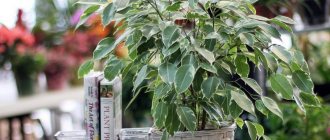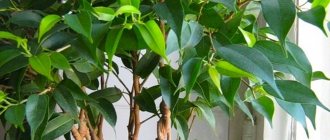Ficus benghalensis is an evergreen tree of the mulberry family, with dense pubescent leaves up to 20 cm long and 6 cm wide. The homeland of ficus bengal is India, namely the territories of Sri Lanka and Bangladesh.
In nature, it grows to gigantic sizes, has aerial roots that fall to the ground, capable of taking root, forming new full-fledged trunks. This feature gave the plant its second name - ficus banyan. The largest banyan tree grows in the Indian Botanical Garden and occupies about one and a half hectares of area. Cultivated indoor specimens reach a height of no more than 1.5-3 m. They have a high development rate - approximately 60-100 cm per year, and are also perennials.
Other ficus:
| Ficus rubber - care and reproduction |
| Ficus microcarpa - care |
| Ficus lyreformes |
| Ficus sacred |
| They have a high development rate - approximately 60-100 cm per year |
| At home, ficus does not bloom. |
| The plant is easy to grow. Suitable for a beginner. |
| Perennial. |
Useful properties of ficus bengal
Ficus not only decorates the interior of the house. This plant is known for its powerful filtering properties, thanks to which the indoor air is purified from harmful impurities such as benzene, ammonia, phenol, and formaldehyde.
In addition, the tree enriches the environment with active substances that have a beneficial effect on human well-being. Ficus is also used in the manufacture of some cosmetics, medications in the form of ointments and tinctures for the treatment of many diseases.
Ficus bengal: care at home. Briefly
Ficus bengal grows easily and without problems at home with the following maintenance nuances:
| Temperature | Above 18 ºС in summer, in winter – not lower than 17 ºС. |
| Air humidity | Average – about 50-60%. |
| Lighting | Intense sunny, south and south-east windows. |
| Watering | Moderate, regular, without stagnation of liquid in the soil. |
| Soil for ficus bengal | Nutritious, slightly acidic, with a neutral pH. |
| Feeding and fertilizer | Alternating mineral and organic nutritional compositions. |
| Transplanting ficus bengal | It is carried out once every 2-3 years, at the end of winter. |
| Reproduction | Layerings, apical cuttings. |
| Features of cultivation | Afraid of drafts. Annual crown formation is necessary. From time to time the tree should be turned to the other side towards the sun. The milky sap of ficus can be dangerous for people suffering from bronchial asthma; it is better to work with the plant with gloves. |
Transfer
Seedlings are transplanted annually in March and April. The pot should be 2-3 cm larger than the stem. Only the top layer of soil needs to be changed - 4-5 cm.
Compost consists of: peat, leaf soil, humus, turf, sand, charcoal and organic matter. After transplantation, secondary feeding is required six months later.
To prevent rotting of the root system, the plant needs a good drainage layer (expanded clay, clay shards or tree bark).
Caring for Bengal ficus at home. Details
Bloom
When grown indoors, the indoor ficus bengal does not bloom. But in greenhouse conditions, there are specimens with syconia - round orangeish seed fruits that are of no decorative value.
Temperature
The optimal maintenance temperature for ficus is 18-22°C, both in summer and winter. Ficus is a tropical tree, so a slight increase in temperature will not harm the plant if a sufficient level of humidity is maintained.
Spraying
Caring for ficus bengal at home involves constantly providing the plant with the required degree of humidity. This can be achieved in several ways:
- spraying once a week, especially in hot weather or in winter if the tree is located near heating systems;
- moisturizing ficus leaves by regularly wiping off dust, or by rinsing in the shower;
- placing the flower in a bowl with wet expanded clay.
It is advisable to spray and otherwise moisten the ficus with warm, softened water.
Lighting
The Bengal ficus prefers well-lit rooms, but also grows well in rooms with diffused light. If partial shade is created on the windowsill with a ficus, it is recommended to periodically turn the plant with different sides to the sun, which will contribute to the uniform development of the crown.
In winter, sunlight can be replaced by artificial lighting.
Watering ficus bengal
Watering is carried out no more than two or three times a week, as soon as the surface layer of soil dries out by about 2 cm. Stagnation of moisture should be avoided, so excess water is always poured out of the pan. In winter, the plant is watered much less frequently - once every 7-10 days.
Pot for ficus bengal
As a rule, there are no special requirements for a ficus pot. It is enough to choose a container of normal proportions suitable for the size of the plant.
A vessel that is too large will cause moisture stagnation and, as a result, rot.
Priming
Ficus Bengal at home is planted in the following soil composition:
- turf (2 parts)
- leaf soil (2 parts)
- sand (1 part)
It can also be a slightly acidic universal substrate.
Feeding and fertilizer
Ficus feeding is carried out all year round, with the exception of the winter period. It is recommended to alternate mineral and organic fertilizers, feeding the plant once every 14 days. In winter, only ficus plants growing in inert soil are fertilized.
Transfer
Replanting the ficus bengal is carried out as soon as the earthen ball of the plant is completely entwined with roots, protruding from the pot.
For mature trees, the period between transplants is 2-4 years. During the replanting procedure, the roots are lightly shaken off the old substrate, placed in a larger container and covered with prepared soil without deepening the root collar. Immediately after transplantation, you should not expect rapid growth of the ficus. It will resume its development only in a month.
How to prune a Bengal ficus
Pruning of the Bengal ficus is necessary to slow down the growth in height of the main branch, the trunk, since the plant tends to sharply stretch out without growing lateral branches. All formative manipulations should be carried out during the active growth phase of the tree, that is, in spring or early summer.
When it is noticeable that the plant has begun to grow, the branch is cut at the required height with pruning shears and, after washing off the milky juice, it is sprinkled with charcoal. This procedure will give an impetus to the awakening of other “dormant” buds and after a while you can expect the tree to branch.
Rest period
The ficus bengal plant at home does not need a well-defined dormant period. Only certain varieties of ficus can “show” the need for rest due to reduced light and temperature.
Suitable microclimate
For the Bengal ficus, it is necessary to create a microclimate similar to the natural tropical one.
Optimal temperatures:
- in summer - no higher than 25°C;
- in winter - at least 16°C.
If the degree drops below the critical level, the flower crop will begin to shed its leaves.
Young ficus trees are susceptible to changes. Their insufficiently strong root system freezes in the supercooled soil, which disrupts the nutrition of the vegetative mass, and the flower dies. To prevent your indoor plant from freezing, it is recommended to use trays in winter and cover the pot with thick fabric.
Humidity
Home ficus requires high humidity - 50% and above. Dry air causes brown spots to appear on the leaves, curling and drying out.
To maintain the indicators at the required level in winter, when the environment is dry due to the active use of central heating, a container of water installed near a flower pot or the use of professional humidifiers helps.
In the summer, in addition to the main waterings, they use spraying on the leaf mass at intervals of up to once a week. In the winter season, indoor ficus is not sprayed.
Illumination
In winter, the flower needs additional light
It is preferable to place the flower pot on the sunny side (south or southeast), avoiding direct light. Diffused lighting is recommended.
During hot periods, when the sun is active, the plant is shaded to avoid burns of the vegetative mass.
In winter, the lack of lighting is compensated by using fluorescent lamps.
The optimal length of daylight is 12 hours. When there is a lack of light, the leaves lose contrast, fade and become deformed.
Reproduction of ficus bengal by layering
Reproduction by layering is practiced only in tall tree-like specimens of ficus. To do this, leaves and branches are removed from the selected section of the trunk, and a circular cut of the bark 1.5 cm wide is made in the middle. You should get two transverse and one longitudinal cut located between them.
All cuts are treated with root formation activators, then wrapped in moistened sphagnum with a margin of 2 cm on each side of the cuts, and all this is secured with polyethylene. The sphagnum is carefully moistened periodically. After a few months, you can observe the appearance of the first layering, which is cut and planted separately.
Propagation of ficus bengal by cuttings
For this method, apical cuttings measuring 15-20 cm are used, cut with a knife at an angle. The lower leaves of the shoot are removed, the upper large leaves are rolled into a tube to prevent moisture evaporation.
The sections are washed to remove juice with warm water and then dried. Cuttings prepared in this way can be rooted in the following ways:
- Rooting in the ground. Shoots treated with stimulants are buried only 1-2 cm into the soil and covered with a bag. It is advisable to organize bottom heating of the soil, for example, placing a cutting in a pot on a radiator, while maintaining high air humidity. If you propagate a tree with large leaves, you can use the middle part of the cutting, which has several internodes.
- Rooting in water. To avoid the occurrence of putrefactive processes, coal is first added to the container with water. After which, the vessel with the cutting is placed in a warm, well-lit place. You can arrange greenhouse conditions. The appearance of roots occurs within 2-3 weeks.
Diseases and pests
Frequent difficulties when growing ficus banyan at home:
- the leaves of the ficus bengal fall off as a result of constant excessive soil moisture;
- the falling of the lower leaves of old plants occurs as a result of the natural process of leaf change;
- Ficus Bengal leaves wither due to insufficient moisture;
- brown spots on the leaves of ficus bengal appear at low air temperatures, from an excess of fertilizers or when in a dry environment;
- leaves sag and wither in too waterlogged soil or in an overly large pot;
- pale leaves of the plant indicate a lack of sunlight;
- ficus bengal grows slowly without regular feeding with nutritional compounds;
- new leaves are small when the ficus is constantly standing in a shaded place;
- Ficus Bengal stretches from insufficient lighting.
If the ficus bengal is left for a long time in a too dry environment, it can become parasitized by pests such as thrips, mealybugs, scale insects, and spider mites.
Botanical characteristics
Ficus Banyan, growing in the wild, has special external characteristics - it grows up to 40 m in length.
Formation begins with the growth of aerial roots on the surface of large branches located in the horizontal direction.
Over a long period, a large number of air layers begin to hang in long garlands. A small part of them reaches the soil and takes root, forming a separate trunk with the subsequent growth of lateral shoots. As a result, a single tree increases the area to several hectares, forming entire forest thickets.
Houseplant description:
- height depends on the conditions created in enclosed spaces, up to 3 m, characterized by active growth, annual growth - up to 0.6-1.0 m;
- the foliage is leathery, dense, length up to 20 cm, width up to 6-10 cm, oval shape, dark green color, light veins, clearly expressed,
When grown at home, flowering is rarely observed; the budding period usually occurs in April-June. The shape of the inflorescences is spherical, formed by yellow flowers of different sexes. The fruits are inedible, small, up to 3 cm in diameter, bright orange in color.











